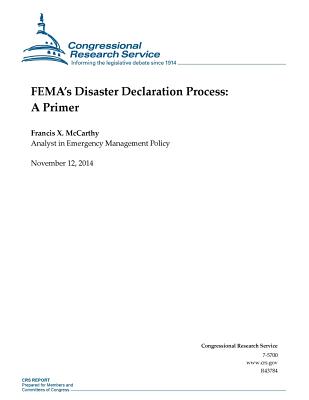You are here
Back to topFEMA's Disaster Declaration Process: A Primer (Paperback)
$19.95
Usually Ships in 1-5 Days
Description
The Robert T. Stafford Disaster Relief and Emergency Assistance Act (referred to as the Stafford Act-42 U.S.C. 5721 et seq.) authorizes the President to issue "major disaster" or "emergency" declarations before or after catastrophes occur. Emergency declarations trigger aid that protects property, public health, and safety and lessens or averts the threat of an incident becoming a catastrophic event. Given their purpose, the emergency declarations may precede an event. A major disaster declaration is generally issued after catastrophes occur, and constitutes broader authority for federal agencies to provide supplemental assistance to help state and local governments, families and individuals, and certain nonprofit organizations recover from the incident. The end result of a presidential disaster declaration is well known, if not entirely understood. Various forms of assistance are provided, including aid to families and individuals for uninsured needs; and assistance to state and local governments, and to certain non-profits for rebuilding or replacing damaged infrastructure. Over the last quarter century, the amount of federal assistance provided through presidential disaster declarations has exceeded $150 billion. Often, in recent years, Congress has enacted supplemental appropriations legislation to cover unanticipated costs. While the amounts spent by the federal government on different programs may be reported, and the progress of the recovery can be observed, much less is known about the process that initiates all of this activity. Yet, it is a process that has resulted in an average of more than one disaster declaration a week over the last decade. The disaster declaration procedure is foremost a process that preserves the discretion of the governor or tribal leader to request assistance and the President to decide to grant, or not to grant, supplemental help. The process employs some measurable criteria for evaluating disaster damage in two broad areas: Individual Assistance that aids families and individuals and Public Assistance that is mainly for emergency work such as debris removal and permanent repairs to infrastructure. The criteria, however, also consider many other factors, in each category of assistance, that help decision makers assess the impact of an event on communities and states. Under current law while a governor or a tribal leader may make a request, the decision to issue a declaration rests solely with the President. Congress has no formal role, but has taken actions to adjust the terms of the process. For example, the Post-Katrina Emergency Management Reform Act of 2006, P.L. 109-295, established an advocate to help small states with the declaration process. More recently, Congress passed the Hurricane Sandy Recovery Improvement Act, P.L. 113-2, which had two potentially major impacts on the declaration process. First, the act authorized Native American tribal groups to directly request disaster assistance from the President rather than only requesting through a state governor. The second potential major impact in the act was that FEMA was directed to update its criteria for considering whether to make a recommendation to the President for Individual Assistance declarations. Since the decision for a declaration is at the discretion of the President, there has been some speculation regarding the influence of political favor in these decisions. Some have posited various connections between the political party of the governor requesting or the prominence of some state's congressional delegation on committee's important to FEMA. While of interest, those theories are usually not connected to, or at least fail to consider, the natural events that were the impetus for both the request and the decision.
